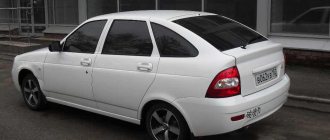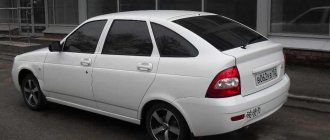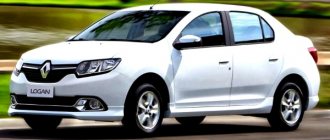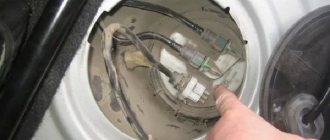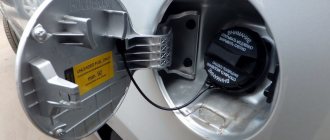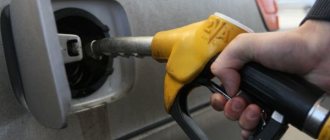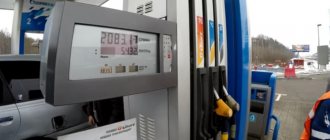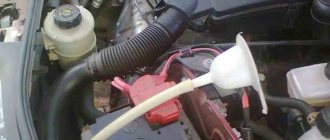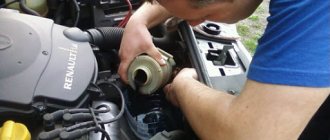How many full liters does the Renault Logan fuel tank hold? This question is asked by many potential buyers of this car, and in fact, it is not unimportant. After all, when this question is clear, you can easily calculate how long the car will travel without refueling on one tank.
In the video you can learn how to see the exact volume of gasoline in liters in the fuel tank.
After reading this article, you will learn not only what the actual volume of the Renault Logan tank is, but also what the fuel consumption per 100 kilometers of the Renault Logan is.
A few words about the car
In Russia, Renault Logan is very popular. And of course, fame came to this car thanks to not only reliability, but also stable fuel efficiency. As for the engines, their volume, depending on the configuration, is 1.4 and 1.6 liters, respectively.
Vehicle Features
Like any other car, Renault Logan has a number of features. Here are some of them:
- Convenient dashboard. Once you get used to this toolbar, there seems to be nothing more attractive than Logan's arrangement of indicators, indicators and buttons.
- Large volume trunk.
- The metal from which the Renault Logan is made is light and thin. This quality can be attributed to both advantages and disadvantages. If the car gets hit by hail, it will immediately affect the body, but the car is light and well balanced.
- Soft and sensitive gear shifting. Shifting gears is easy and the car's steam is sensitive and responds quickly to incoming commands.
- The car's chassis is reliable and suitable not only for European roads. The car was tested in the most difficult off-road conditions.
- Logan is equipped with two live French engines of 1.4 and 1.6 liters. Both engines work like clockwork.
- Electronics and lighting technology are on par with Japanese cars.
- Large fuel tank. The volume of the tank causes confusion among drivers who fill it up.
It is worth dwelling on the last point.
Volume of the tank
Based on the manufacturer's manual, you can find out that the volume of the fuel tank on Renault Logan is 50 liters, but in fact it can hold a little more
This is because when the fuel heats up, the volume of the fuel can increase, so the fuel from the filling station is always cooled.
Most car enthusiasts know that it is not recommended to fill up with fuel and proceed from the rule that 5% of the full capacity is subtracted from the full volume of the fuel tank, thereby obtaining 48-49 liters of valuable fuel. But sometimes, when there is not a single gas station kilometers Oil level in the gearbox - Forum about the New Renault Logan 2 (Renault Logan 2) Therefore, if you fill a 50-liter tank with 52 liters of fuel, nothing critical will happen.
How much fuel to fill
The official 50 liters give no rest to anyone. Therefore, on the Internet you can find information about the volume of 68 liters, but whatever you say, it will be 50. There are different arguments and different calculations. You can even hear versions that since gas tanks are made by inflating, and as they were inflated, that’s what happened.
In fact, manufacturers always reserve an extra liter for tank safety, which usually hovers around 15% of the official capacity. This takes into account the expansion of liquids and gases when heated, stabilizes instrument readings without pushing them into the afterlife, and prevents the fuel pump from operating in extreme conditions with a full or almost empty gas tank.
A Renault tank of 50 liters on a good country road should be enough for 694 kilometers, but some Logan drivers claim that they were able to drive 1000 km at a gas station “under the neck”. This means that their Logan has a 72-liter gas tank. Renault officials smile and, without blinking an eye, report a volume of 50 liters.
Although the gasoline engines that Logan is equipped with have different power and number of valves, they have the same working volume of combustion chambers 1.6, so fuel consumption is almost the same.
Unlike the 1.6-liter engine, the 1.4-liter diesel will be able to travel 909 km on a 50-liter fill-up.
And “if it’s under the neck,” then even more.
Fuel pump
A part consisting of several elements and performing:
- • purification of fuel from foreign particles;
- • supply of fuel according to the required doses to the nozzles;
- • return of excess gasoline to the fuel system.
The electric drive is responsible for the operation of the Renault Logan fuel pump, the operation of which is controlled by the ECU. By pressing the accelerator, the amount of fuel supplied to the combustion chamber is regulated.
The feasibility of having this element in the tank is determined by the likelihood of reducing air pockets. After all, gasoline is supplied by pressurization, and not under the influence of a rarefied environment.
The fuel pump also contains a fuel regulator. It creates the required pressure in the central circuit in all engine operating modes.
The design of the fuel pump also includes a fuel indicator. It consists of a holder, a float and a variable resistor, which determines the electrical resistance at various positions of the float, transmitting them to the fuel sensor. This design is simple, but also reliable. However, it has some drawbacks. Therefore, drivers have disagreements at gas stations about underfilling and disputes among themselves about the real capacity of the Renault Logan tank.
Logan's fuel pump is accessed through the rear seat, which reclines, and through a special hatch under the seat. The hatch has an arrow that points to the latch. Press on it with a screwdriver and access is open. To open completely, move the lid to the side.
Logan 1.6 MT 2008–present. 1st generation van
| Combined fuel consumption (l/100 km) | 8.1 |
| Tank volume (l) | 50 |
| Fuel consumption on the highway (l/100 km) | 6.5 |
| City average (l/100 km) | eleven |
| Environmental standard | EURO III |
| Acceleration time to 100 km/h (sec) | 13,4 |
| Maximum speed (km/h) | 167 |
| Recommended fuel | AI-95 |
Why is this situation?
But the diesel Logan will most likely cover this distance much slower than a Renault equipped with a 1.6 petrol engine, unless it catches up at the gas station. Therefore, it is difficult to understand which is better - a turbo diesel or 1.6 liter gasoline. and how much and on what you can save. It all depends on your driving style.
Dimensions
Chassis
Fuel
Engine
The most common fuel tank sizes in cars are 40, 50, 60 and 70 liters. Judging by the volume of the tank, you can tell how big the car is. In the case of a 30 liter tank, we are most likely talking about a small car. 50-60 liters is a sign of a strong middle peasant. And 70 indicates a full-size car.
The volume of the fuel tank would be a useless quantity if it were not for fuel consumption. Knowing the average fuel consumption, you can easily calculate how many kilometers a full tank of fuel will last you. On-board computers of modern cars are able to quickly show this information to the driver.
The volume of the Renault Logan fuel tank is 50 liters.
The Renault Logan Stepway City is undergoing a long test in the “Behind the Wheel” park. During operation, I was able to thoroughly study the functionality of the machine. Here is one of the features that even the owners of such cars are not aware of.
Renault > Logan
Many car owners wonder how long they can drive with the low fuel level indicator on. There can be no exact answer. Everything is very approximate. But in the case of Logan or other Renault models on the B0 platform, you can find out how much gasoline remains in the tank with an accuracy of up to. liters True, only owners of the first generation Logan have this opportunity. The main condition: the presence of a button on the dashboard.
The algorithm of actions is as follows: while holding down the button on the instrument panel, turn on the ignition, but do not start the car. You need to hold the button pressed until a combination of numbers appears on the display. At the same time, the odometer and tachometer needles will begin to move chaotically - this is normal. Using the same button, we scroll through the on-board computer readings until it shows the remaining fuel in the tank in liters. After this, you can fill the tank until full and find out the actual capacity of the tank along with the filler neck. According to reports on forums, it was possible to fill the tank of the first generation Logan with 63 liters of fuel under the cap.
According to the operating instructions, the second generation Logan gas tank is designed for 50 liters (approximately). What about in real life? During my operation, I visited a gas station more than once with the low fuel level indicator on. As a result, the maximum amount of gasoline that could be filled into the tank of the editorial car at one time was 49 liters.
By the way, the instructions also say that the low fuel indicator comes on when the remaining mileage is approximately 50 km. In fact, you need to try very hard and constantly press the accelerator pedal to the floor while driving in order to use up this remainder in 50 km. Depending on your driving style, you can travel from 70 to 100 km. But it’s better not to delay refueling until the last sip of the gas pump.
You can operate any editorial vehicle in our “ZR Park” section.
- Many people know that it is better to check gasoline before refueling. This can be done using a rapid test. If low-quality fuel has already entered the tank, use a “first aid kit” - an IFO gasoline modifier.
Logan 1.6 AT Prestige (2012) 2009–present. 1st generation sedan
| Combined fuel consumption (l/100 km) | 8,4 |
| Tank volume (l) | 50 |
| Fuel consumption on the highway (l/100 km) | 6,7 |
| City average (l/100 km) | 11,8 |
| Environmental standard | EURO IV |
| Acceleration time to 100 km/h (sec) | 11,7 |
| Maximum speed (km/h) | 175 |
| Recommended fuel | AI-92 |
Features and technical capabilities
The car is available in several versions with gasoline engines with a power of 82, 102, 113 hp, which are coupled with a five-speed manual or 4-speed automatic transmission. Technical characteristics of Renault Logan are not inferior to the best cars in its class:
- dimensions – 4359x1733x1523 mm;
- engine volume – 1.6 l;
- maximum speed – 177 km/h;
- fuel consumption per 100 km in the combined cycle – 6.6 l;
- acceleration to 100 km/h – 10.7 s;
- fuel tank volume – 50 l;
- trunk capacity – 510 liters.
Folding rear seats allow the body to be reconfigured to transport passengers and cargo. Already in the basic version, the 2020-2021 Renault Logan is equipped with an anti-lock braking system, a driver's airbag, and Isofix mounts for two child seats. The machine is adapted to Russian conditions thanks to pre-installed crankcase protection, anti-corrosion coating with a 6-year warranty, adaptation of engine starting to negative temperatures, and heated rear window.
Logan 1.5 dCi MT – new century 1st generation MCV station wagon
| Combined fuel consumption (l/100 km) | 5,3 |
| Tank volume (l) | 50 |
| Fuel consumption on the highway (l/100 km) | 4.8 |
| City average (l/100 km) | 6.2 |
| Environmental standard | EURO IV |
| Acceleration time to 100 km/h (sec) | 18 |
| Maximum speed (km/h) | 150 |
| Recommended fuel | D.T. |
Logan 1.2 MT 2013–present 2nd generation sedan
| Combined fuel consumption (l/100 km) | 6.2 |
| Tank volume (l) | 50 |
| Fuel consumption on the highway (l/100 km) | 5.2 |
| City average (l/100 km) | 7,8 |
| Environmental standard | EURO IV |
| Acceleration time to 100 km/h (sec) | 14,5 |
| Maximum speed (km/h) | 156 |
| Recommended fuel | AI-95 |
Logan 1.4 MT Authentique (2013) 2009–present. 1st generation sedan
| Combined fuel consumption (l/100 km) | 6.9 |
| Tank volume (l) | 50 |
| Fuel consumption on the highway (l/100 km) | 5.5 |
| City average (l/100 km) | 9,4 |
| Environmental standard | EURO IV |
| Acceleration time to 100 km/h (sec) | 13 |
| Maximum speed (km/h) | 162 |
| Recommended fuel | AI-92 |
Logan 1.5 dCi MT 2013–present. 2nd generation sedan
| Combined fuel consumption (l/100 km) | 4.5 |
| Tank volume (l) | 50 |
| Fuel consumption on the highway (l/100 km) | 4.1 |
| City average (l/100 km) | 5,3 |
| Environmental standard | EURO IV |
| Acceleration time to 100 km/h (sec) | 14,5 |
| Maximum speed (km/h) | 168 |
| Recommended fuel | D.T. |
Logan 1.4 MT Expression (2012) 2009–present. 1st generation sedan
| Combined fuel consumption (l/100 km) | 6.9 |
| Tank volume (l) | 50 |
| Fuel consumption on the highway (l/100 km) | 5.5 |
| City average (l/100 km) | 9,4 |
| Environmental standard | EURO IV |
| Acceleration time to 100 km/h (sec) | 13 |
| Maximum speed (km/h) | 162 |
| Recommended fuel | AI-92 |
What to put in the tank?
You can find out what kind of fuel to fill on the gas tank cap or in the vehicle's operating instructions.
All the necessary information is indicated on the gas tank cap.
The official dealer adheres to its position and recommends AI-92 for refueling.
Fuel quantity
The passport states that the fuel tank holds 50 liters of gasoline. In fact, the gas tank capacity is slightly larger - there is a subsection in the article that explains this feature. Most motorists know that it is not recommended to fill the gas tank to the neck. And this is correct, this rule can be explained by the fact that at high temperatures the volume of fuel increases. It’s not for nothing that the service station always cools the fuel. But sometimes exceptions have to be made, especially when the driver knows that there will be no refueling for the next 300-400 kilometers.
Fuel can heat up not only due to high ambient temperatures, but the reason may be long-term use of the car, a large amount of dust under the hood, and so on. To calculate how much fuel to fill, you need to subtract about 5% of the total tank capacity. For example, 47-49 liters is enough for Logan, but if you fill in 52, the fuel will not return.
Neck
This structural element is not just a pipe for filling fuel, as many Renault Logan owners think. The part contains a plastic ventilation tube. It is designed to remove excess air from the tank, which enters the tank along with the fuel during refueling. This ensures that excess gasoline does not spill out of the tank. The amount of air removed is equal to the amount of fuel added. At the same time, the ventilation duct, neck and fuel tank capacity are a single piece that is supplied only as a kit and cannot be separated.
The upper part of the filler neck is closed with a lid, which is also an integral element of the car body. It also serves as protection against excessive contamination of the neck. The neck itself is closed with a stopper with a lock. Many Renault Logan car owners do not like the presence of a lock because of its inconvenience, so after purchase, most install a new plug without a lock. To secure the cork, it is tied to the lid with a cord.
This is interesting: Changing the oil in a box in a Peugeot 206 - photos and videos
Logan 1.4 MT Expression (2013) 2009–present. 1st generation sedan
| Combined fuel consumption (l/100 km) | 6.9 |
| Tank volume (l) | 50 |
| Fuel consumption on the highway (l/100 km) | 5.5 |
| City average (l/100 km) | 9,4 |
| Environmental standard | EURO IV |
| Acceleration time to 100 km/h (sec) | 13 |
| Maximum speed (km/h) | 162 |
| Recommended fuel | AI-92 |
Logan 1.6 AT Expression (2012) 2009–present. 1st generation sedan
| Combined fuel consumption (l/100 km) | 8,4 |
| Tank volume (l) | 50 |
| Fuel consumption on the highway (l/100 km) | 6,7 |
| City average (l/100 km) | 11,8 |
| Environmental standard | EURO IV |
| Acceleration time to 100 km/h (sec) | 11,7 |
| Maximum speed (km/h) | 175 |
| Recommended fuel | AI-92 |
Tank volume Renault Logan 2009, 1st generation, sedan, restyling, LS
The model was produced from 09.2009 to 06.2016.
| Equipment | Fuel tank volume, l | Type of fuel |
| 1.4 MT expression | 50 | Gasoline AI-92 |
| 1.4 MT Authentic | 50 | Gasoline AI-92 |
| 1.6 MT expression | 50 | Gasoline AI-92 |
| 1.6 AT Prestige | 50 | Gasoline AI-92 |
| 1.6 AT expression | 50 | Gasoline AI-92 |
| 1.6 MT Prestige | 50 | Gasoline AI-92 |
| 1.6 million tons Silverline | 50 | Gasoline AI-92 |
| 1.6 million tons of Arctic | 50 | Gasoline AI-92 |
| 1.4 MT finished | 50 | Gasoline AI-92 |
| 1.4 MT Prestige | 50 | Gasoline AI-92 |
| 1.4 t base | 50 | Gasoline AI-92 |
| 1.4 MT Environment | 50 | Gasoline AI-92 |
| 1.5 dCi MT End | 50 | Diesel fuel |
| 1.5 dCi MT Prestige | 50 | Diesel fuel |
| base 1.5 dCi MT | 50 | Diesel fuel |
| 1.5 dCi MT Medium | 50 | Diesel fuel |
| 1.6 MT finished | 50 | Gasoline AI-92 |
| 1.6 MT Prestige | 50 | Gasoline AI-92 |
| 1.6 t base | 50 | Gasoline AI-92 |
| 1.6 MT Environment | 50 | Gasoline AI-92 |
How does the fuel level indicator in the tank work?
The basic principle of operation of any sensor is quite simple - there is a measuring device located directly in the fuel tank and there is a converter of the received signal into a “more understandable” one, which is displayed on the fuel level indicator on the dashboard.
Interesting materials:
How can you earn money at 12 or 13 years old? How to start running at 40 years old and overweight? How to write in English if I am 8 years old? How is parental leave paid for up to 3 years? How do I translate in English I am 8 years old? How to transport children over 7 years old? How to change your name at 13 years old? How to remember for 5 years? How to understand how old a Cactus is? How to plant potatoes in summer?
Why are there such discrepancies in measuring tank volume?
Many people simply do not take into account the fact that fuel tends to expand and contract in volume depending on temperature. At the gas station, fuel is always kept cold, which can result in more than 53 liters of fuel, but this should not be done, especially in hot weather. If fuel begins to accumulate, it may spill inside the vehicle.
Thus, by filling the fuel tank to capacity, the driver, at best, risks losing some of the spent gasoline. In the worst case, there is a fire hazard.
It is not for nothing that the Renault Logan service passport contains the figure of 50 liters: the thoughtful Frenchman scrupulously tried to take into account all possible factors influencing the change in fuel volume: heating of gasoline, the fuel itself can be used differently. In addition, the special technology for manufacturing the tank is unique - it is made in one piece according to the principle of quenching glass flasks, so there may be slight differences in size.
Gasoline filter
The tank filter is designed to clean fuel from foreign fractions. This extends the life of the injectors. In 2006 Renault Logan versions, the filter is part of the fuel pump. On its predecessors it was located in the rear wheel area on the right under the gas tank.
According to the factory recommendation, the filter is changed once every two years. However, the operating conditions of the machine in the Russian Federation require replacing this component once a year.
In earlier versions, you could install a new filter yourself without any problems. Now you will also need to replace the fuel pump, which requires contacting a car service.
What to fuel the car with?
What kind of fuel should go into the gas tank, after the driver opens the cap, can be found out from the cap itself. He says the car must run on unleaded gasoline with an octane rating higher than 91.
How much fuel to fill has already been said, now you can decide which gasoline is better to choose for Logan with 1.4 or 1.6, because there is no specific data on the gas tank cap.
Official dealers and experts recommend choosing brand 92, as it has the best price-quality ratio. Relatively few impurities have been added to 92 fuel that damage the elements of the power plant. Of course, with AI-95 Logan becomes more dynamic.
Volume of oils and fuel fluids Renault Logan
A car, as everyone knows, consumes not only gasoline, but also contains additional filling fluids. But often car owners go to a service center because they don’t know how and how much to fill antifreeze, hydraulics, motor oil into the engine, etc. And that’s why go to a service center and pay your own money when you can do it all yourself . If you are the owner of Renault Logan, then you are very lucky that you have come to this page, because we will talk about this particular car.
Fuel tank in Renault Logan
And I had a hard time getting to the gas station with grams of gasoline. There was definitely a liter or two left there.
I go to the official website of the dealer. An online consultant comes to mind - this reserve allows you to take into account the expansion of fuel and air when heated, normalizes instrument readings without forcing the needle to cross the scale.
In addition, this Renault Logan 2006 tank capacity is the ability of the fuel pump to work normally with a full or almost empty tank. The tank volume of the French model Renault Logan is 50 liters, and on a good road outside the city it will be enough for one km. Some drivers, according to them, managed to cover a kilometer in a Renault with a full tank of fuel. In other words, their fuel tank capacity should be 72 liters.
The volume of the fuel tank on Renault Logan or how many liters can be filled before the cut-off?
But official representatives of the French concern claim that the volume of the Renault Logan 2006 tank cannot exceed 50 liters, and therefore they are amused by such information, as well as the fact that the owners of the model are trying to find out what volume in liters of the tank, despite the official data. Despite the different layout of Renault Logan engines in terms of power and number of valves, the volume of their combustion chambers is the same as that of 1.
Therefore, gasoline consumption is identical. In this case, diesel 1.
Thanks to the small engine volume of 1.4 and 1.6 liters, fuel consumption is moderate. It is recommended to use unleaded gasoline as fuel, the octane number of which starts with. To avoid confusion, you need to take another look at the gas tank cap. To refuel Renault Logan, experts recommend using gasoline, since it contains the least amount of impurities that damage spark plugs.
Although many car enthusiasts claim that when the car runs on gasoline, the dynamics improve significantly.
Declared and actual fuel consumption of Renault Logan 2006 Logan tank volume Information on fuel consumption per km in the passport is recorded by the manufacturer.
The following data were obtained: in urban mode - from 9.2 to 10 liters; Outside the city - from 5.5 to 5.7 liters; Mixed cycle - from 6.8 to 7.2 liters. As practice shows, these data do not always correspond to reality.
However, travel conditions have a slight effect on fuel consumption. Here are the practical data: in urban mode - from 9.5 to 10 liters; Outside the city - from 5.5 to 6.5 liters; Mixed cycle - from 6.5 to 8.5 liters.
What to put in the tank? What kind of fuel to fill can be found on the gas tank cap or in the instructions for the Renault Logan 2006 car tank volume. All the necessary information is indicated on the gas tank cap.
The official dealer sticks to its position and recommends AI for refueling
What do the experts say?
There is an opinion that if while driving the sensor shows that gasoline is at zero, there is no need to worry, there are at least 5 liters of fuel in the tank. The fact is that Renault Logan was created precisely for those countries where the quality of the road surface is absent or leaves much to be desired. Therefore, the suspension in this car is reliable and can withstand the harshest climatic conditions, and fuel consumption does not increase while driving off-road.
Renault Logan is inexpensive to maintain and operate. Thanks to the small engine capacity (1.4 and 1.6 liters), fuel consumption is moderate. It is recommended to use unleaded fuel as fuel, the octane number of which starts from 91. To avoid confusion, you need to take another look at the gas tank cap.
To refuel Renault Logan, experts advise using 92-grade gasoline, since it contains the least amount of impurities that harm spark plugs. Although many motorists claim that when the car is running on 95 gasoline, the dynamics improve significantly.
This is interesting: Installing and connecting a rear view camera Renault Duster: we describe it point by point
Why does it hold more fuel than indicated in the passport?
Most foreign car manufacturers create a special reserve of free space intended for fuel. Opening the technical description passport, the driver sees a standard number, in the case of Renault Logan it is 50 liters. This is also done so that when pouring more than 50 liters under the cap, the fuel does not run out.
The extra space under the lid will only please the motorist, because there is enough fuel for a long journey. For example, Logan's fuel tank will run out only after 500 kilometers.
If there are no gas stations in front of you, you need to fill the gas tank just below the gorge to protect yourself from unforeseen circumstances. In this way, the driver can continue driving safely for many hours. The Renault Logan is a car that doesn't need tanks because its excellent economics make them useless on the road. Now readers know how much and what kind of fuel needs to be filled into Renault Logan.
Sources
- https://rinkball.ru/objom-i-jomkost-toplivnogo-baka-reno-logan-skolko/
- https://portal-mashin.ru/logan/renlog-specification/obem-toplivnogo-baka-reno-logan.html
- https://logan-50.ru/inomarki/ob-em-i-emkost-toplivnogo-baka-reno-logan-skol-ko-lit-do-polnogo.html
- https://razborov.net/renault/rashod-topliva-renault-logan.html
- https://soloserv.ru/avto/obem-benzobaka-reno-logan-renaul-logan-14-i-16-s-2004-po-nv-tablicza
- https://fastmb.ru/harakteristiki/bak/5550-obem-toplivnogo-baka-reno-logan.html
- https://loganlogan.ru/articles/reno-logan-obem-benzobaka.html
Tank volume
Based on the manufacturer's manual, you can find out that the fuel tank capacity of Renault Logan is 50 liters
, but in reality it can hold a little more
This is because as the fuel heats up, the volume of the fuel can increase, so the fuel from the filling station is always cooler.
Most motorists know that it is not recommended to fill fuel “to the neck” and proceed from the rule that 5% of the full capacity is taken from the full volume of the fuel tank, thereby obtaining 48-49 liters of valuable fuel. But sometimes, when the next 350-450 kilometers of road there are no gas stations, you must make exceptions to these rules. Transmission oil level - Forum about the New Renault Logan 2 (Renault Logan 2) Therefore, if you pour 52 liters of fuel into a 50-liter tank, nothing critical will happen.
Renault Logan
operation.
How much
fuel d
tank
.
How much
exact
number
of fuel d
Logan Tank
Sandero Dater Largus? Or how to get diagnosed...
Remember that fuel heating occurs not only from the ambient temperature, but also from the cleanliness of the engine compartment and the duration of continuous operation.
Why is this more relevant?
The strict number is 50,
in the Renault Logan passport, this does not mean that exceeding this value will lead to fuel spilling over the edge, but will only warn about its maximum permissible amount.
The vast majority of foreign car manufacturers purposefully create a reserve of free space in the gas cylinder. Remember that there is excess fuel in the fuel line and fuel filter under the vehicle floor.
Free space in the gas tank will only benefit the motorist. What is engine oil and how many liters are in the Kaptura engine? It is recommended to fill the engines of the new Evolution 900 SXR 5W40 or 5W30 with original Renault Kaptur synthetic motor oil. So the owner of a Renault Logan can count on a long trip without refueling, because the fuel supply will run out in just 450-500 kilometers.
Logan long-distance drivers prefer to fill their car's gas tank up to their necks rather than carry extra cans. Complain that the car is very efficient, but the various tanks and fuel tanks are completely useless on the road.
